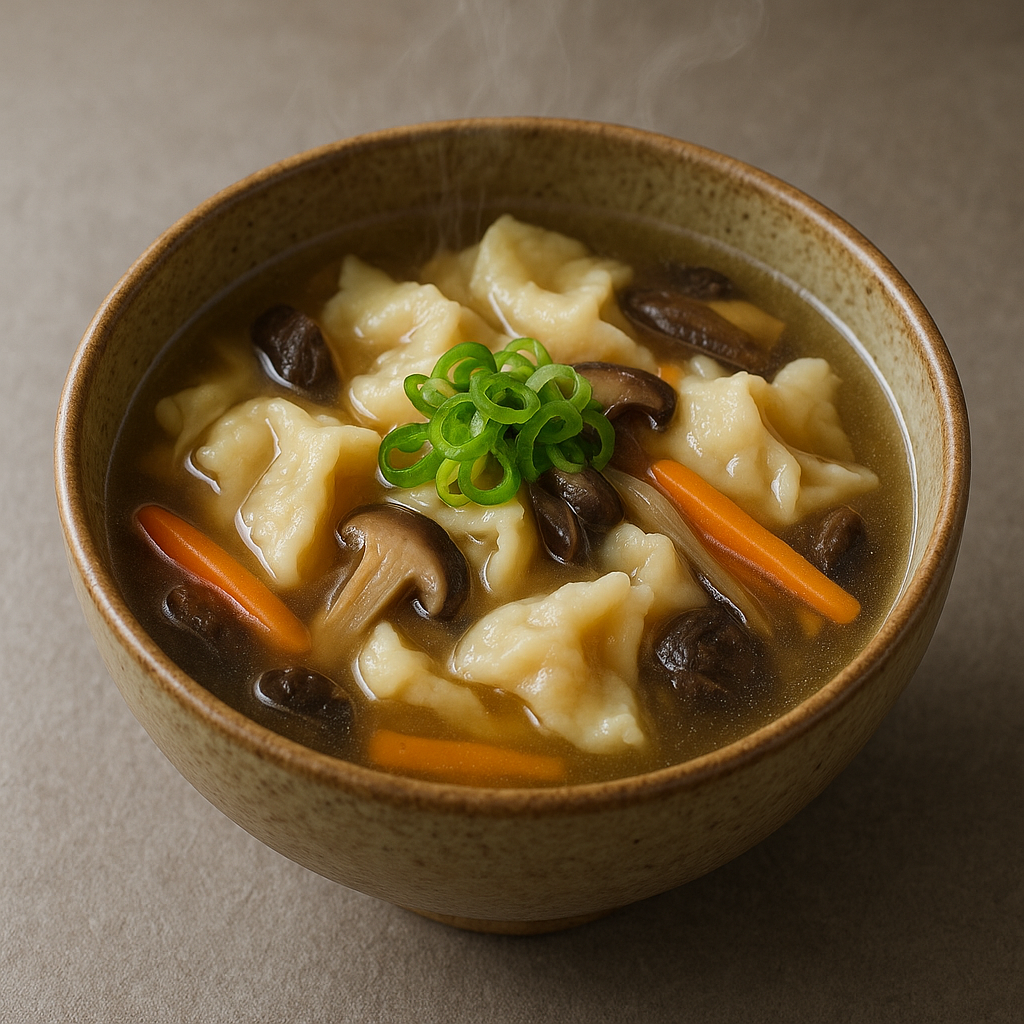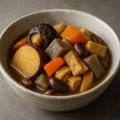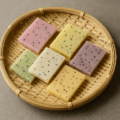ひっつみ汁の特徴
手で“ひっつまんで”落とす、北東北の粉もの汁
ひっつみ汁は、塩をきかせた小麦生地を手で薄くのばしてちぎり、だしで煮る郷土料理。青森東部から岩手の南部地方に伝わり、素朴な小麦のうまさと具だくさんの汁が調和します。
もちっと薄のばし、つるりと喉ごし
生地は耳たぶ程度にこねて休ませ、1~2mmまで薄くのばしてちぎるのが基本。ふちの不揃いが汁をつかみ、つるりとした喉ごしに。
鶏だし×根菜で滋味深く
鶏ももとごぼう、にんじん、きのこ、長ねぎなどを醤油ベースで。味噌仕立ても定番で、季節や家ごとに具や味が変わります。
ひっつみ汁のレシピ
材料(4人分)
- ひっつみ生地:薄力粉または中力粉 200g/塩 小さじ1/3/水 110〜130ml(様子を見て)
- 具:鶏もも肉 200g(一口大)/ごぼう 1/2本(ささがき)/にんじん 1/2本(短冊)/しいたけ 3〜4枚(薄切り)/長ねぎ 1本(斜め切り)
- だし・調味:だし 900ml(昆布+かつお、または鶏がらでも可)/酒 大さじ1/みりん 大さじ1/醤油 大さじ2〜3/塩 少々
作り方
- 生地:粉と塩を混ぜ、水を少しずつ加えてこねる(3〜4分)。耳たぶ程度になったらラップで包み、30分以上休ませる。
- だし:鍋にだしを沸かし、鶏肉を入れてアクを取る。ごぼう・にんじん・しいたけを加え、中火で7〜8分。
- のばしてちぎる:生地を手に取り、指で薄く引きのばしながら一口大にちぎる(1〜2mm厚)。沸いた汁へ直接落とす。
- 煮る:生地を全部落としたら、みりん・醤油・酒で調味。2〜3分煮て火を通し、長ねぎを加えてひと煮立ち。塩で味を整える。
- 仕上げ:火を止めて1〜2分休ませ、椀によそう。
シェフのワンポイントアドバイス
生地は休ませるほど伸びやすくなります。薄く不揃いにのばすと食感に抑揚が出て良いですね。
打ち粉は基本不要ですが、手に軽く水をつけると扱いやすいです。
味噌仕立てなら醤油を減らし、仕上げに少量の味噌を溶いてください。
栄養価(1杯の目安)
- エネルギー:約320〜430 kcal
- たんぱく質:18〜25 g
- 脂質:8〜14 g
- 炭水化物:45〜60 g(生地・野菜由来)
主食+主菜+副菜が一椀で完結。生地量でボリュームを、鶏皮の有無や調味で脂質・塩分を調整しやすいです。
歴史
粉食文化と“手延べ・手ちぎり”の知恵
米が乏しい時季の腹持ちの良い食事として広がり、行事や来客のもてなしにも用いられてきました。宮城の「はっと」、岩手の「ひっつみ」、青森の「つめり」など呼び名や仕立てに地域差があります。
家庭ごとに受け継がれる味
醤油清湯・味噌・鶏がら・煮干しなどベースは多彩。季節のきのこや根菜、油揚げを合わせ、土地の味として受け継がれています。
English Version
Features of Hittsumi Soup
A hand-pinched flour soup of northern Tohoku
Hittsumi-jiru is a regional soup made by stretching salted wheat dough thin with your fingers, pinching off pieces, and cooking them in broth. From eastern Aomori through Iwate’s Nanbu area, the simple wheat flavor meets a hearty, ingredient-rich broth.
Thinly stretched, chewy—smooth to slurp
Knead the dough to earlobe softness and rest it, then stretch to 1–2 mm and tear. The irregular edges “catch” the broth for a silky, slurpable texture.
Deep, comforting broth of chicken and roots
Chicken thigh with burdock, carrot, mushrooms, and long green onion in a soy-based broth is classic. A miso version is also common—ingredients and seasoning vary by season and household.
Recipe
Ingredients (serves 4)
- Dough: All-purpose (or medium-strength) flour 200 g / Salt 1/3 tsp / Water 110–130 ml (as needed)
- Fixings: Chicken thigh 200 g (bite-size) / Burdock root 1/2 stalk (shaved) / Carrot 1/2 (batons) / Shiitake 3–4 caps (thinly sliced) / Long green onion 1 (on a bias)
- Broth & seasoning: Dashi 900 ml (kombu + katsuobushi, or chicken stock) / Sake 1 tbsp / Mirin 1 tbsp / Soy sauce 2–3 tbsp / Salt a pinch
Instructions
- Dough: Mix flour and salt; add water gradually and knead 3–4 minutes. When earlobe-soft, wrap and rest for 30 minutes or more.
- Broth: Bring dashi to a boil; add chicken and skim. Add burdock, carrot, and shiitake; simmer 7–8 minutes over medium heat.
- Stretch & pinch: Take dough in hand, pull it thin with your fingers (1–2 mm), and pinch off bite-size pieces, dropping them directly into the simmering broth.
- Cook: After all pieces are added, season with mirin, soy sauce, and sake. Simmer 2–3 minutes until set; add the long green onion and bring just to a boil. Adjust salt.
- Finish: Turn off the heat and rest 1–2 minutes before serving.
Chef’s Tip
Rested dough stretches easier. Tear pieces thin and irregular for lively texture. Dusting isn’t needed—lightly wetting your hands helps handling. For a miso style, reduce soy sauce and dissolve a little miso at the end.
Nutritional Value (per bowl, approx.)
- Calories: 320–430 kcal
- Protein: 18–25 g
- Fat: 8–14 g
- Carbohydrates: 45–60 g (from dough and vegetables)
A complete bowl of staples: starch + protein + vegetables. Adjust portion with dough amount; manage fat and salt with skin-on/off chicken and seasoning.
History
Flour-based fare and the wisdom of hand-stretching & pinching
Adopted as a filling meal when rice was scarce, it also became hospitality fare for guests and festivals. Names and styles vary by region—Miyagi’s “hatto,” Iwate’s “hittsumi,” Aomori’s “tsumeri.”
A household taste passed down
Clear soy broth, miso, chicken stock, niboshi—bases are diverse. Seasonal mushrooms and roots, or abura-age, shape each locale’s signature bowl.



何でも質問してください!